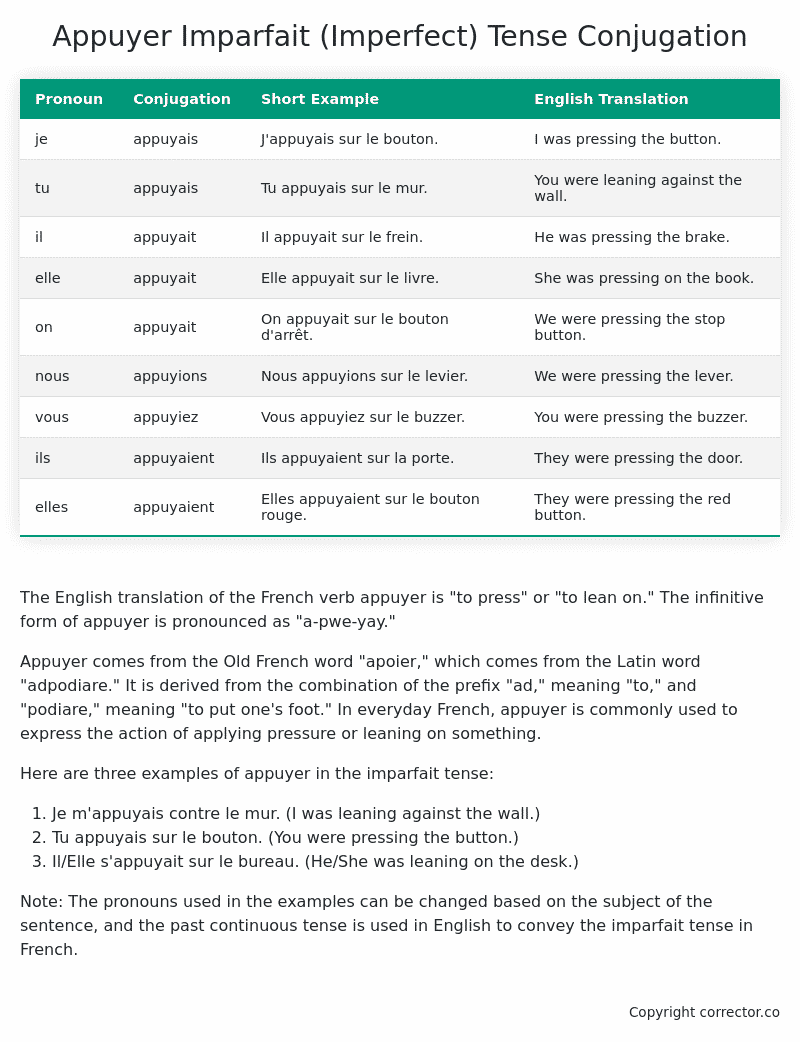Imparfait (Imperfect) Tense Conjugation of the French Verb appuyer
Introduction to the verb appuyer
The English translation of the French verb appuyer is “to press” or “to lean on.” The infinitive form of appuyer is pronounced as “a-pwe-yay.”
Appuyer comes from the Old French word “apoier,” which comes from the Latin word “adpodiare.” It is derived from the combination of the prefix “ad,” meaning “to,” and “podiare,” meaning “to put one’s foot.” In everyday French, appuyer is commonly used to express the action of applying pressure or leaning on something.
Here are three examples of appuyer in the imparfait tense:
- Je m’appuyais contre le mur. (I was leaning against the wall.)
- Tu appuyais sur le bouton. (You were pressing the button.)
- Il/Elle s’appuyait sur le bureau. (He/She was leaning on the desk.)
Note: The pronouns used in the examples can be changed based on the subject of the sentence, and the past continuous tense is used in English to convey the imparfait tense in French.
Table of the Imparfait (Imperfect) Tense Conjugation of appuyer
| Pronoun | Conjugation | Short Example | English Translation |
|---|---|---|---|
| je | appuyais | J’appuyais sur le bouton. | I was pressing the button. |
| tu | appuyais | Tu appuyais sur le mur. | You were leaning against the wall. |
| il | appuyait | Il appuyait sur le frein. | He was pressing the brake. |
| elle | appuyait | Elle appuyait sur le livre. | She was pressing on the book. |
| on | appuyait | On appuyait sur le bouton d’arrêt. | We were pressing the stop button. |
| nous | appuyions | Nous appuyions sur le levier. | We were pressing the lever. |
| vous | appuyiez | Vous appuyiez sur le buzzer. | You were pressing the buzzer. |
| ils | appuyaient | Ils appuyaient sur la porte. | They were pressing the door. |
| elles | appuyaient | Elles appuyaient sur le bouton rouge. | They were pressing the red button. |
Other Conjugations for Appuyer.
Le Present (Present Tense) Conjugation of the French Verb appuyer
Imparfait (Imperfect) Tense Conjugation of the French Verb appuyer (You’re reading it right now!)
Passé Simple (Simple Past) Tense Conjugation of the French Verb appuyer
Passé Composé (Present Perfect) Tense Conjugation of the French Verb appuyer
Futur Simple (Simple Future) Tense Conjugation of the French Verb appuyer
Futur Proche (Near Future) Tense Conjugation of the French Verb appuyer
Plus-que-parfait (Pluperfect) Tense Conjugation of the French Verb appuyer
Passé Antérieur (Past Anterior) Tense Conjugation of the French Verb appuyer
Futur Antérieur (Future Anterior) Tense Conjugation of the French Verb appuyer
Subjonctif Présent (Subjunctive Present) Tense Conjugation of the French Verb appuyer
Subjonctif Passé (Subjunctive Past) Tense Conjugation of the French Verb appuyer
Subjonctif Imparfait (Subjunctive Imperfect) Tense Conjugation of the French Verb appuyer
Subjonctif Plus-que-parfait (Subjunctive Pluperfect) Tense Conjugation of the French Verb appuyer
Conditionnel Présent (Conditional Present) Tense Conjugation of the French Verb appuyer
Conditionnel Passé (Conditional Past) Tense Conjugation of the French Verb appuyer
Conditionnel Passé II (Conditional Past II) Tense Conjugation of the French Verb appuyer
L’impératif Présent (Imperative Present) Tense Conjugation of the French Verb appuyer
L’impératif Passé (Imperative Past) Tense Conjugation of the French Verb appuyer
L’infinitif Présent (Infinitive Present) Tense Conjugation of the French Verb appuyer
L’infinitif Passé (Infinitive Past) Tense Conjugation of the French Verb appuyer
Le Participe Présent (Present Participle) Tense Conjugation of the French Verb appuyer
Le Participe Passé (Past Participle) Tense Conjugation of the French Verb appuyer
Struggling with French verbs or the language in general? Why not use our free French Grammar Checker – no registration required!
Get a FREE Download Study Sheet of this Conjugation 🔥
Simply right click the image below, click “save image” and get your free reference for the appuyer imparfait tense conjugation!

Appuyer – About the French Imparfait Tense
NOTE: To take a deep dive into all the French tenses then see our article on Mastering French Tense Conjugation.
Formation of the Imparfait Tense
For regular -er verbs:
For regular -ir verbs
For regular -re verbs
Common Everyday Usage Patterns
Description of Past Habits
Background Information
Mental and Emotional States
It’s employed to express emotions, thoughts, or physical sensations in the past. For example: “J’étais content quand il est arrivé.” (I was happy when he arrived.)
Ongoing Actions
Points to Note About the Imparfait Tense
Passé Composé vs. Imparfait
Conditional
Si Clauses
Narration
I hope you enjoyed this article on the verb appuyer. Still in a learning mood? Check out another TOTALLY random French verb imparfait conjugation!


